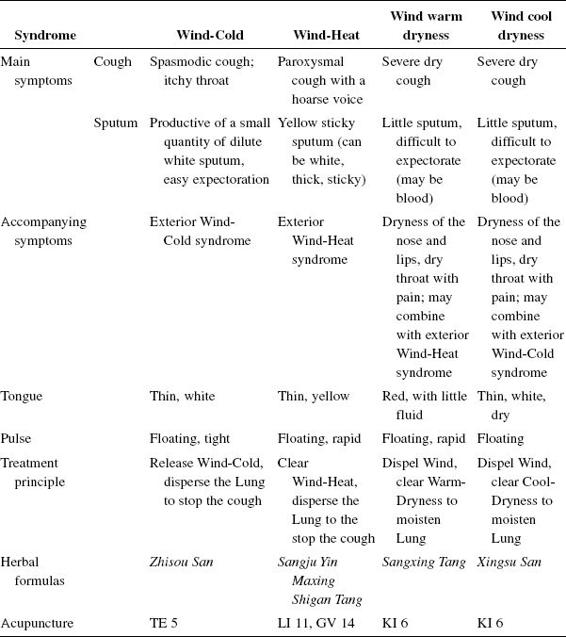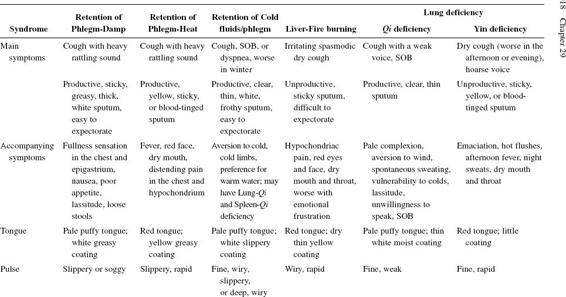The Introduction of Cough
Definition
Cough is a chief symptom of Lung diseases caused by reverse flow of Lung-Qi. It is called Ke Sou in Chinese. “Ke” means “cough without Phlegm but with sound;” “Sou” means “cough with Phlegm but with no sound.” It is typical to see the two presented at the same time, which is why cough is usually called Ke Sou.
Corresponding diseases in CWM
- Bronchitis
- Asthma (early- and late-stage)
- Flu, common cold
- Whooping cough
- Upper respiratory tract infection
- Lung tumor
- Tuberculosis
- Pneumonia
- Emphysema
- Heart disease
- Bronchiectasis
The Etiology of Cough
External injury
- Six environmental pathogens, especially Wind, disturb the Lung system.
- Wind-Cold is the most common pattern in the clinic, but Wind-Heat, Wind-Dryness, and Wind-Damp are also possible, along with others.
Internal injury
(1)Dysfunction of other organs affects the Lung
- Emotional frustration (e.g. anger) leads to Liver-Qi stagnation, which could turn into Liver-Fire and invade the Lungs.
- Improper lifestyle and diet (e.g. alcohol, smoking, spicy food, or fatty food) damage the Spleen and Stomach, creating Damp-Heat which is stored in the Lung.
(2)Lung disease
- Many Lung diseases, like the lingering common cold, affect the Lung’s dispersing and descending function, which leads to cough.
The Pathology of Cough
Chief pathology
- Adverse flow of Lung-Qi.
- Exogenous cough belongs to excess. Endogenous cough presents both excess and deficiency. Phlegm and Fire are the chief pathological factors in endogenous cough.
Organs involved
- The lung is the major organ. The Liver, Spleen, and Kidney are related organs.
- Cough can be caused by the disorder of any Zang–Fu organ.
Inter-transformation
- If an exogenous cough is not relieved, it will damage Zheng Qi, leading to an endogenous cough.
- If there is an endogenous cough due to weak Zheng Qi, the Lungs are easily invaded by EPFs, which is why endogenous cough easily combines with exogenous cough.
How to Diagnose and differentiate Cough(see Table 22)
Distinguish exogenous from endogenous cough
(1)Exogenous
- Acute onset.
- Short duration.
- Combines with exterior syndrome signs and symptoms.
- Belongs to excess.
(2)Endogenous
- Chronic or recurrent.
- Slow onset.
- No exterior syndrome signs and symptoms.
- Belongs to mixed excess and deficiency syndrome.
Differentiate syndromes with the chief complaint
In general, quiet cough is deficiency and loud cough is excess.
(1)Types of cough
- Loud voice, spasmodic cough, itchy throat, more severe during daytime than nighttime → acute (Wind-Cold or Wind-Heat);

Basic points: GB 20, LI 4, LU 7, 5, BL 13, LU 1.
Zhisou San (Stop Cough Powder).
Sangju Yin (Mulberry Leaf and Chrysanthemum Decoction).
Maxing Shigan Tang (Ephedra, Apricot Kernel, Gypsum, and Licorice Decoction).
Sangxing Tang (Mulberry Leaf and Apricot Kernel Decoction).
Xingsu San (Apricot Kernel and Perilla Leaf Powder).
- Cough that is severe in the morning; spasmodic cough that is heavy, turbid, and unclear and is relieved after expulsion of phlegm (Phlegm-Damp or Phlegm-Heat).
- Cough that is severe in the afternoon or evening or many single coughs at night; soft, short cough; low cough (Lung-Yin deficiency or Dryness).


Erchen Tang (Two-Cure Decoction).
Pingwei San (Calm the Stomach Powder).
Sanzi Yangqin Tang (Three-Seed Decoction to Nourish One’s Parents).
Qinqi Huatan Wan (Clear Qi and Transform Phlegm Pills).
Xiao Qinglong Tang (Minor Blue–Green Dragon Decoction).
Sangdan Xiebai Tang (Mulberry Leaf and Moutan Decoction to Drain the White).
Wenfei Tang (Warm the Lung Decoction).
Xiangsha Liujunzi Tang (Six-Gentleman Decoction with Aucklandia and Amomum).
Baihu Gujin Tang (Lily Bulb Decoction to Preserve Metal).
- Cough that is severe when one is lying down at night, constant cough at night, dyspnea, shortness of breath (deficiency Cold).
(2)Aggravating factors for cough
- Aggravated by fatty, sweet or raw, cold food (Phlegm-Damp).
- Aggravated by emotions (Liver-Fire).
- Aggravated by overwork or EPFs (Phlegm-Damp or deficiency Cold).
(3)Quality of the voice
- A hoarse voice with acute onset and short duration (caused by EPFs: Wind-Cold, Wind-Heat, Wind-Dryness).
- A hoarse voice with chronic onset and long duration (Yin deficiency or Qi deficiency).
(4)Phlegm
- Cough with little phlegm (Dryness, Liver-Fire, Yin deficiency).
- Cough with profuse phlegm (Damp, Phlegm, Phlegm-Heat, deficiency Cold).
- White, thin phlegm (Cold).
- White, profuse, thick phlegm that is easy to expectorate → Damp.
- Yellow, thick phlegm → Heat.
- White, sticky phlegm (can also be light yellow) → Yin deficiency or Dryness.
- White, thin, watery, frothy phlegm → deficiency Cold.
- Blood-tinged sputum → Lung-Heat or Yin deficiency.
- Phlegm with a fishy or fetid odor → Phlegm-Heat (e.g. pulmonary abscess with three-layered Phlegm).
- Phlegm with a sweet taste (Phlegm-Damp).
- Phlegm with a salty taste (Kidney deficiency).
The Treatment of Cough
Principle of treatment
Determine exogenous or endogenous cough first, in order to understand the pathology.
(1)Exogenous cough
- Remove the pathogenic factor(s).
- Disperse and descend the Lung to stop the cough.
For Wind-Cold:
- Disperse Wind.
- Remove Cold.
- Diffuse the Lung.
For Wind-Heat:
- Disperse Wind.
- Clear Heat.
- Diffuse the Lung.
For Warm-Dryness:
- Disperse Wind.
- Clear the Lung.
- Moisten Dryness.
(2)Endogenous cough
- Tonify the root (usually LU or SP/ST).
- Remove the pathogenic factor(s) (usually Phlegm or Fire) to stop the cough.
Herbal medicine
See Table 22.
Acupuncture
Commonly used points
- LU 1, 7, 10
- LI 4
- BL 13
For exogenous cough, the Lung Meridian of Hand Taiyin and the Large Intestine Meridian of Hand Yangming will yield the main points. The reducing method is applied.
Wind-Cold → moxa or cupping.
Wind-Heat (combined with bleeding).
Sore throat [LU 11, LI 1 (bleed)].
Dry cough (LU 5, 10).
For endogenous cough, the Lung Meridian of Hand Taiyin, the Spleen Meridian of Foot Taiyin, the Large Intestine Meridian of Hand Yangming, and the Stomach Meridian of Foot Yangming will be chosen from for the main points. Liver and Kidney Meridians may also be necessary.
Moxa
- Group 1: GV 14, BL 13, CV 22
- Group 2: GV 13, EX-B 1 (Dingchuan), CV 21
- Group 3: GV 12, BL 12, CV 20
- Group 4: GV 11, BL 14, CV 17
Rotate the four groups for chronic bronchitis or asthmatic cough.
Auricular
- Lung
- Trachea
- Shenmen
- Liver
- Adrenal
Plum blossom needle
- GV Meridian on the neck or upper back
- Throat
- GV Meridian on the neck or upper back
- Throat
Light tapping once per day.
Suggestions
- Keep warm and avoid EPFs.
- Avoid spicy food, as it will stimulate the airway and trigger the cough. Also avoid smoke for the same reason.
- Facial massage around the LI 20 area can prevent EPF invasion and help sinus problems.
- Moxa ST 36 at night to strengthen Zheng Qi.
- For chronic cough, Qi Gong is recommended to build Zheng Qi (conventional exercise is more likely to consume Lung-Qi).
- For endogenous cough, regulate the emotions and diet, and avoid airborne irritants such as paint or gasoline.
Summary
Exogenous cough is generally easy to cure, although if it is combined with Damp or Dryness it is not as easy to cure and is more likely to linger and develop into endogenous cough.
Endogenous cough is usually chronic. The location of the disease is deeper and the disease is not easy to cure.
Lung-Qi deficiency may combine with Spleen and Kidney deficiency. This pattern is usually aggravated by EPF invasion. Aim to balance Biao (EPF) and Ben (Lung-Qi deficiency) in such cases.
Lung-Yin deficiency looks mild at the beginning (usually just a single cough at night), but it easily lingers and becomes increasingly aggravated over time. This pattern can eventually combine with pulmonary tuberculosis.

